
https://youtu.be/Ji2XDxmXSOM
Python Poetry in 8 Minutes

As soon as you start writing more complicated Python scripts , it becomes really important to properly manage your dependencies .
You're going to use a bunch of other libraries and packages and you want to make sure that you have the versions right ?
Commonly used to to handle dependencies is poetry , which is what I use for most of my part , different projects and next on handling dependencies .
This can also do other things such as creating virtual environments for your code to run in , but also publish your code , your packages to Pipi .
So today I'll walk you through the basics of poetry and give you some tips and tricks for how to set up and manage your project effectively .
Before we start , I have something for you .
It's a free guide that teaches you how to design a new piece of software from scratch .
You can get it at Iron dot Code slash design guide .
It contains the seven steps that I take whenever I design a new piece of software .
And hopefully it helps you avoid some of the mistakes that I made in the past Iron dot Code slash design guides .

Link is also in the description of this video dependencies in Python have been handled in different ways .
The past one very basic way to handle dependencies is just Pip install whatever you need in your global Python installation .
That's not a really great way to go because that means that you may have version conflicts .
It will also be hard to keep track of when you want your script to run somewhere else .
What dependence you actually need to install .
So it makes sense to at least have some representation of what the dependencies are supposed to be as part of your Python project .
Common way to do that has been requirements dot TXT , but it's easy to misfigure and kind of hard to update .
And that's why since the 518 the P project dot tomo file has been introduced here .
You see an example of what such a file might look like .
So it has various sections .
So there are general package settings like the name and the version description you can refer to read me file .
There are dependencies .

In this case , we have a Python 3.12 dependencies and you also have built system settings by putting all of this information into a single file .
You don't need a separate requirement dot TXT and a setup dot P I manifest and other things , it's all in one tool file .
Now , you can in principle directly edit this file , it's a text file .
So you can just add your dependencies here , but it's kind of cumbersome and it's in my opinion , better to use a tool like poetry to handle that automatically for you .
For example , if I want to use poetry to add a dependency on pest , I can simply write poetry , a pie test .
And now you see it has installed a bunch of different things .
And if we open the tomo file poetry now has added pie test for us .
And on top of that , it has also installed other packages that Pie test depends on .
And if you type poetry show , then you can see the packages that it has installed , including the version .
So this you can run at any time to see what is the status of your dependencies .

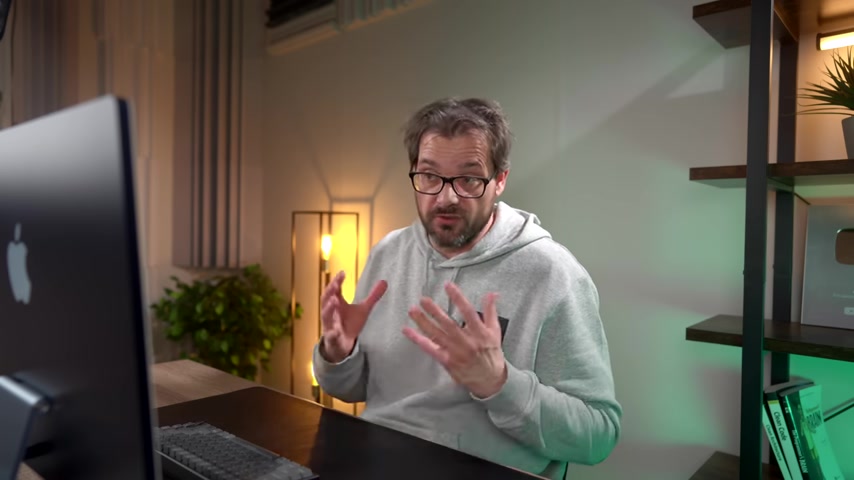
The first time you add a package , poetry also creates a poetry dot log file and this is what that looks like .
Now this is a file that you typically don't have to edit yourself .
It's really an internal file for poetry to keep track of the dependencies .
Next to just adding a dependency .
Poetry has other options as well .
You can also remove dependencies or update them to the latest version using semantic versioning .
Let's explore this a little bit more poetry .
A it is used to add dependencies like I've just shown before .
So for example , let's say I want to add the requests package which is quite commonly used for HTP request .
I can use the ad sign to specify a specific version , for example , 2.12 0.1 .
So when I do this , now it has added request version 2.12 .
And you can also see it's here in the list .
And when I open the by project file , you also see that the request package has been added here .
And as you can see it has installed this specific version .
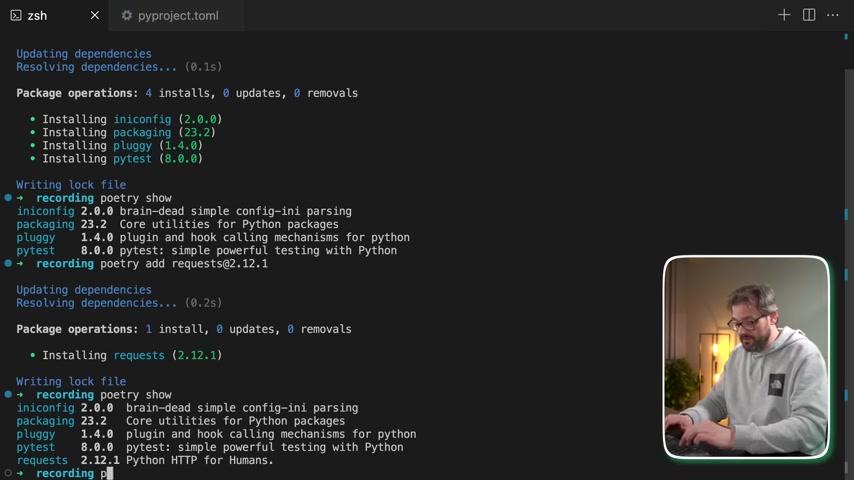
So if I want to remove the seat , I simply write poetry , remove request in this case .
And now it has removed that particular dependency .
Now , typically I don't install specific versions of packages .
I just want to give some sort of limitation to how we want the upgrade process to take place .
So what I typically do is install the package like so and what this character does is that it installs the most recent version following this version up until the major version .
So it won't install a request version three for example .
But as you can see , it goes up to 2.31 0.0 .
So it's a minor version and not a major version update .
And when you look at a project file , you also see that it has added this specification to the version number .
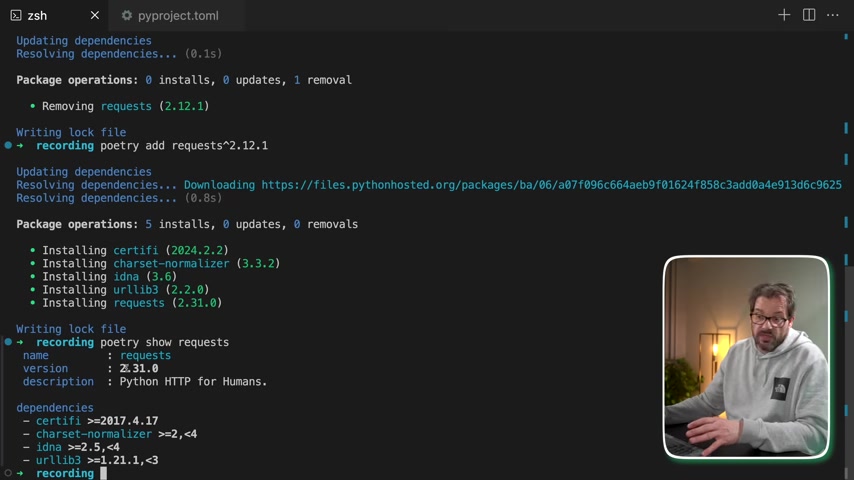
Now , if I type poetry show and I can even add these specific package that I want to show , they see it shows the name of the package , the description as well as the version that's actually installed or just write poetry show to show everything .
And they will see it as the request package at 2.31 0.0 .
Let's remove that dependency again .
So another alternative is that we add requests using the tilda and the tilda is a bit more restrictive in that it only installs the package up to the latest minor version .
So you see here , it has installed 2.12 0.5 instead of 2.12 0.1 but it doesn't switch to 2.13 .
So basically what you do in both of these cases that you sort of define an upper and a lower bound .
And when you're just starting out with a new project , you probably just want to add the latest version of a package .
But it's helpful to know that this gives you some control over what dependency version you're going to use .

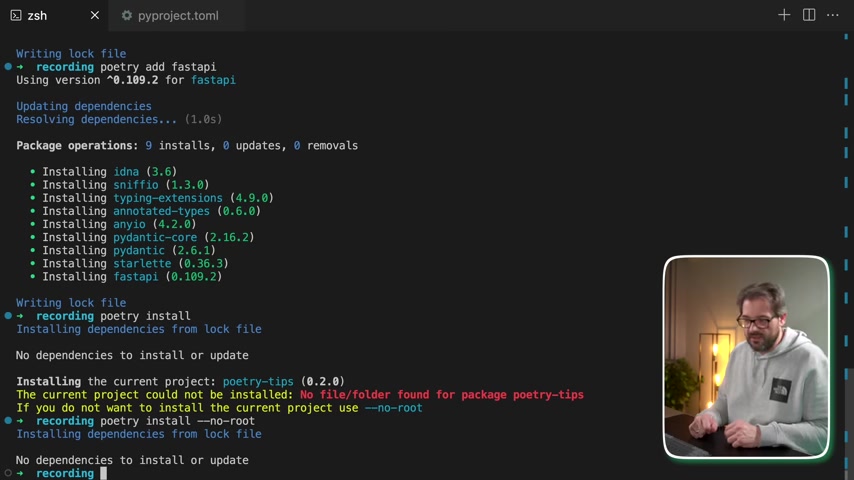
What I'd recommend you use when you install dependencies is the carrot that to me is good , sweet spot between having maintenance overhead and having no control whatsoever over the versions .
And by the way , this is also what poetry does by default .
So for example , if I add fast API , then you also see if I look at the Piro Thermo file that it actually uses the Carrot character by default when you have a P project file , and you simply want to install all the dependencies in it , you write poetry install and then it's going to simply install all of the dependencies .
So you see there is in this current project , no specific folder for this particular package .
So you can also say that there is no root folder and then you don't get that error but it does install dependencies in both .
Now , when you have the dependencies , install poetry , you can also create a virtual environment for you within which you can run your code and you simply write poetry shell to go into that virtual environment .
And then within that environment , you can simply run your Python script .

So it's really easy to use in the vs code term .
You can actually see which virtual environment you are in .
And in this case , in my recording folder , it has created a dot VM folder that contains all the information related to the virtual environment .
Now , poetry also offers some help with versioning building and publishing your package .
So currently the version of this package is 0.2 0.0 .
But if we want to bump the version number , we can simply write poetry version minor and this uses semantic versioning to go to the next version .
So this goes from 0.2 0.0 to 0.3 0.0 .
And this is also reflected in the P project file .
Normally the P project file is something that you commit in your G report story .
So that the latest version number is also available there .
Now there are other things you can do related to semantic version like 1.0 0.0 dash alpha one or release candidate .
There's lots of things to cover .
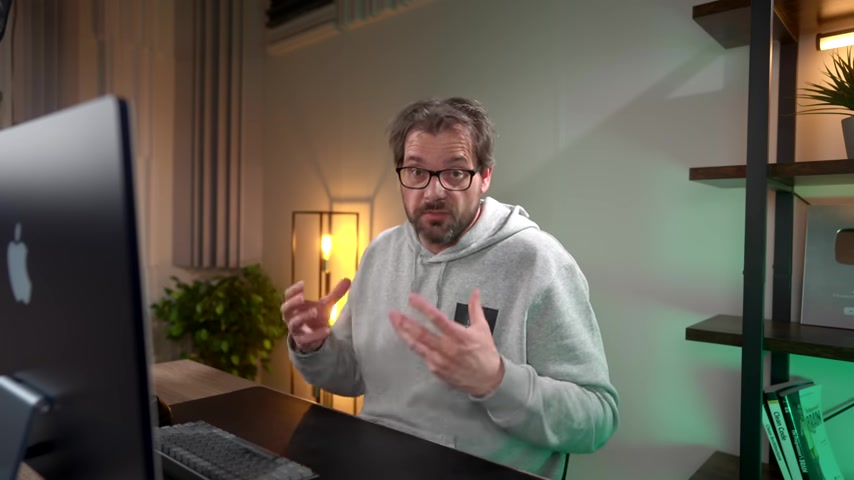
I might do a separate video about semantic versioning if you like me to do that .
Let me know in the comments .
Now , when you are ready to unleash your project into the world , poetry can also package your project into distributable format such as a wheel or a source distribution TG zip file .
And then when you're done building , you write poetry , publish and then supply your pipe credentials and then you can publish it to pipe .
And of course , all of these things you can also do that in , let's say a github workflow .
So that whenever you commit to a particular branch that's automatically going to run this task or whenever you publish attack on github , lots of possibilities there to automate things and simplify your life .
So I hope this gave you a quick idea of what you can do with poetry .
Highly recommend you start using it .
Now , if you want some inspiration , some ideas from nice Python projects , you could work on to improve your skills .
Watch this video .
Next .
Thanks for watching and see you soon .

Are you looking for a way to reach a wider audience and get more views on your videos?
Our innovative video to text transcribing service can help you do just that.
We provide accurate transcriptions of your videos along with visual content that will help you attract new viewers and keep them engaged. Plus, our data analytics and ad campaign tools can help you monetize your content and maximize your revenue.
Let's partner up and take your video content to the next level!
Contact us today to learn more.